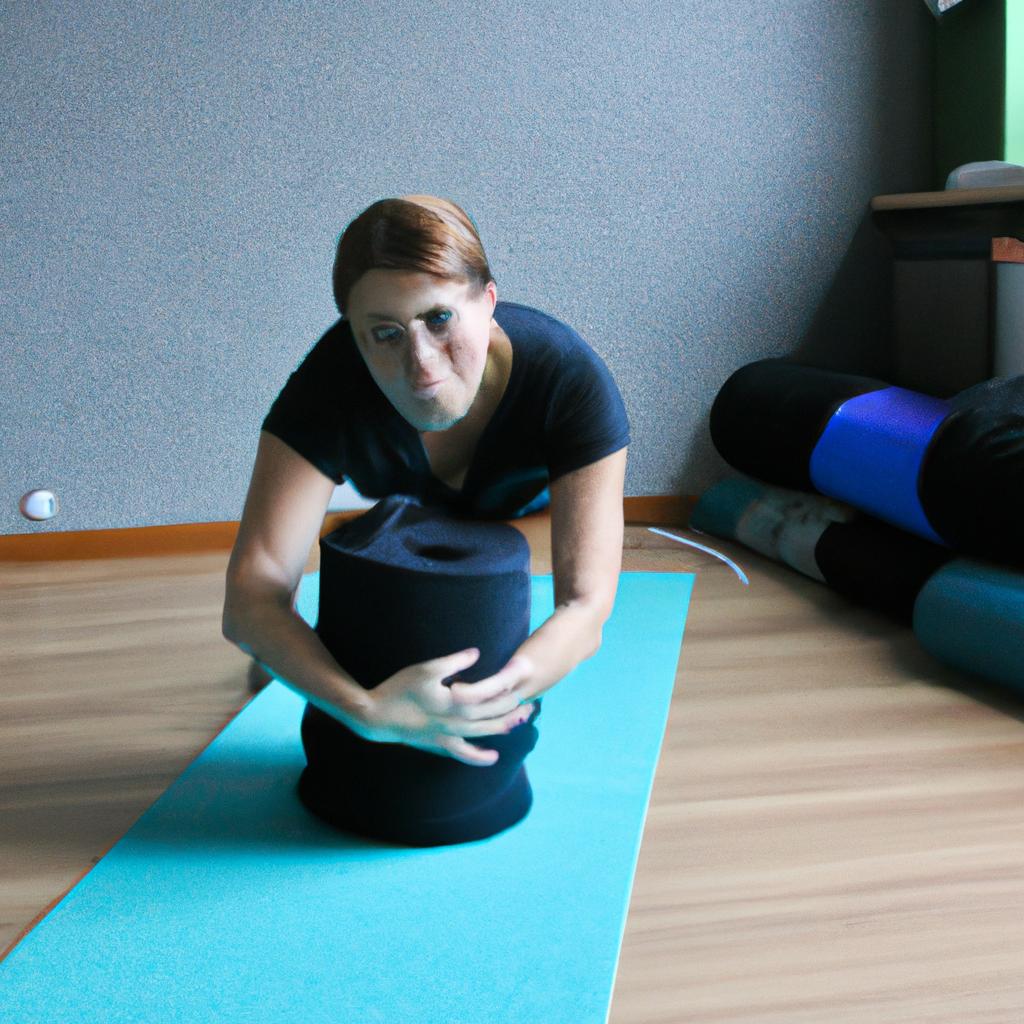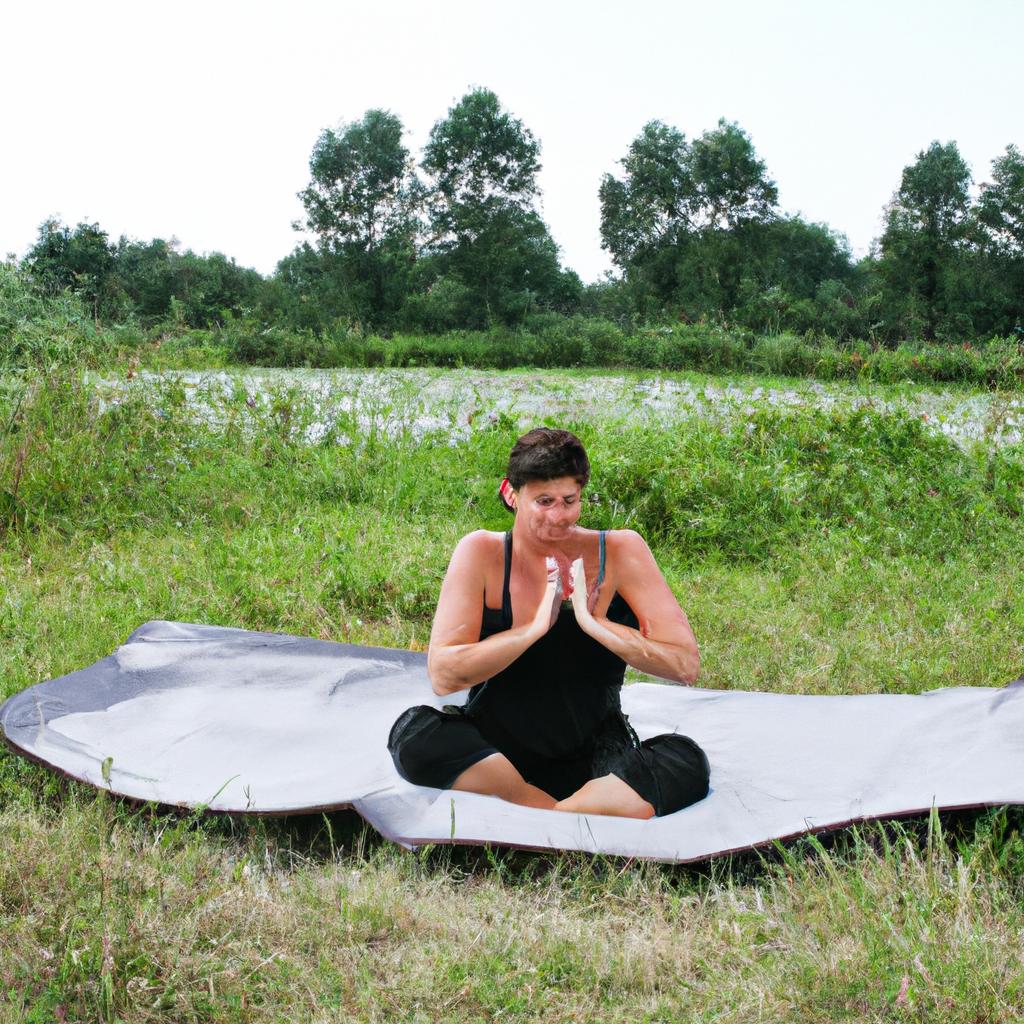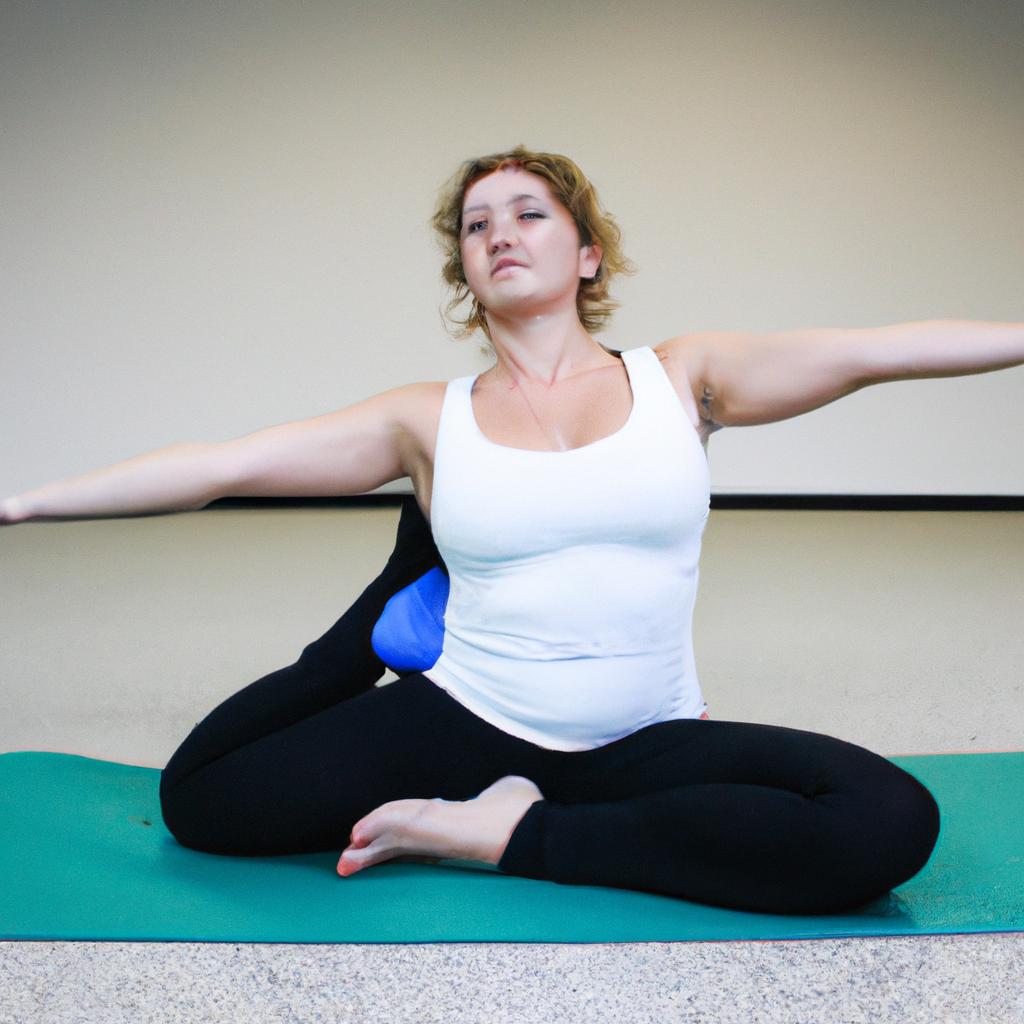Yoga blocks have become increasingly popular in the world of yoga due to their ability to enhance and support various poses. These essential tools are designed to provide stability, alignment, and comfort during practice, making them invaluable for both beginners and experienced yogis alike. For instance, imagine a beginner attempting to master a challenging pose like Utthita Trikonasana (Extended Triangle Pose). Without the assistance of a yoga block, they may struggle with maintaining proper alignment or feel discomfort in their lower back or hips. However, by strategically placing a block under their hand or foot, they can elevate themselves to find balance and alleviate any strain on their body.
The use of yoga blocks not only aids in achieving correct alignment but also allows practitioners to gradually deepen stretches and build strength over time. By modifying poses using these props, individuals can work at their own pace while still reaping the benefits of each posture. Furthermore, yoga blocks serve as versatile tools that can be utilized in numerous ways throughout a session. Whether used as supports for seated meditation postures or as extensions for reaching the floor in standing poses, these compact accessories offer endless possibilities for enhancing one’s yoga practice.
Overall, incorporating yoga blocks into your routine can greatly enhance your experience on the mat. From providing extra support and stability to helping with alignment and deepening stretches, these versatile props are a valuable addition to any yoga practice. Whether you’re a beginner looking for assistance in mastering challenging poses or an experienced yogi aiming to refine your practice, yoga blocks can help you achieve your goals. So don’t hesitate to grab a couple of these essential tools and explore the endless possibilities they offer in enhancing your yoga journey.
Benefits of Using Yoga Blocks
Yoga blocks are essential tools that can enhance the practice of yoga in various ways. One example is when a beginner practitioner attempts to perform a standing forward fold, but finds it challenging due to limited flexibility in their hamstrings. By placing a yoga block on the ground and resting their hands on it, they can gradually deepen the stretch without compromising their form or risking injury.
Using yoga blocks offers several benefits that contribute to an effective and safe yoga practice. Firstly, they provide support and stability, allowing practitioners to maintain proper alignment while performing different poses. This is particularly beneficial for individuals with limited flexibility or those recovering from injuries. Secondly, utilizing these props helps increase accessibility in certain postures by providing additional height or lengthening arms’ reach. Consequently, beginners who may struggle with balance or strength can still experience the full benefits of each pose.
To illustrate further, here is a markdown-formatted bullet point list highlighting some emotional responses associated with using yoga blocks:
- Increased confidence: Yoga blocks offer stability and support, enabling practitioners to explore new poses with less fear of falling or losing balance.
- Enhanced relaxation: The added assistance provided by yoga blocks allows practitioners to relax into poses more deeply, promoting greater physical and mental relaxation.
- Empowered practice: Utilizing props like yoga blocks creates a sense of empowerment as individuals witness their progress and ability to modify poses according to their unique needs.
- Injury prevention: With the aid of yoga blocks, practitioners can avoid straining muscles or joints by gradually working towards achieving proper alignment and depth in each posture.
Additionally, incorporating a table into this section would evoke an emotional response among readers by visually presenting information about the benefits of using yoga blocks:
| Benefit | Description |
|---|---|
| Improved Alignment | Yoga blocks help align the body correctly during poses, preventing strain and supporting good form. |
| Expanded Range | They provide extra length or height, allowing practitioners to achieve poses they couldn’t otherwise. |
| Gentle Modifications | Yoga blocks allow for modifications that make yoga accessible and safe for people of all abilities. |
| Progression and Growth | Practitioners can gradually increase the difficulty level by utilizing yoga blocks in their practice. |
In summary, using yoga blocks during a yoga practice offers numerous benefits ranging from increased confidence and relaxation to injury prevention and progression. In the following section about “Different Types of Yoga Blocks,” we will explore the various options available in the market today.
Different Types of Yoga Blocks
Transition from previous section:
Having explored the benefits of using yoga blocks, it is now important to understand the different types available in order to make an informed choice. Understanding these variations will not only enhance your yoga practice but also allow you to tailor your experience according to your specific needs and preferences.
Types of Yoga Blocks
To better grasp the range of options available when choosing a yoga block, let’s consider an example scenario. Imagine a practitioner who has been struggling with flexibility while attempting certain poses due to limited range of motion in their hips. By incorporating a cork yoga block into their practice, they are able to gradually increase their hip mobility by providing additional support and stability during challenging postures such as Half Moon or Revolved Triangle.
When selecting a yoga block that suits individual requirements, there are several factors worth considering:
- Material: Yoga blocks can be made from various materials such as foam, cork, or wood. Each material offers unique characteristics in terms of density, durability, and gripping ability.
- Size: The dimensions of a yoga block determine its functionality. While most standard blocks measure around 9 inches long, 6 inches wide, and 4 inches high; some manufacturers provide larger or smaller options catering to specific body types or intended purposes.
- Weight: A lighter block may be preferred for travel or those seeking portability, whereas heavier blocks offer enhanced stability during more advanced poses.
- Texture: The surface texture plays a crucial role in grip and comfort. Some individuals may find smooth surfaces easier on their skin, while others appreciate the added traction provided by textured finishes.
| Material | Pros | Cons |
|---|---|---|
| Foam | Lightweight and affordable | May lose shape over time |
| Cork | Durable and eco-friendly | Slightly heavier than foam |
| Wood | Sturdy and aesthetically pleasing | Heaviest option |
Considering these factors allows practitioners to select a yoga block that complements their practice, promotes growth, and aligns with personal values. By understanding the diverse options available, one can confidently choose a yoga block that enhances their yoga journey.
Transition to subsequent section:
Now equipped with knowledge about the different types of yoga blocks, it is time to move forward and explore how to choose the right one for your specific needs. Understanding key considerations will ensure you select a yoga block that aids in achieving optimal support during your practice.
How to Choose the Right Yoga Block
Transition from the previous section:
With a better understanding of the different types of yoga blocks, let us now delve into how to choose the right one for your practice.
Section H2: How to Choose the Right Yoga Block
To illustrate the importance of choosing the appropriate yoga block, consider this hypothetical example: Sarah is an intermediate yogi who has been practicing for several years. She recently started experiencing discomfort in her wrists during certain poses, such as downward-facing dog and plank. After consulting with her instructor, she realizes that using a taller and denser yoga block could provide additional support and alleviate unnecessary strain on her wrists.
When selecting a yoga block, there are several factors to consider:
- Material: Yoga blocks can be made from various materials including foam, cork, or wood. Each material offers different levels of grip, firmness, and durability.
- Size: The size of the yoga block determines its height and width. A standard size block is typically 9 inches long by 6 inches wide by 4 inches tall. However, some practitioners may require taller blocks based on their individual needs.
- Density: The density of a yoga block affects its stability and supportiveness. Softer blocks provide more give while firmer ones offer increased stability.
- Weight: While not often considered initially, weight can play a role in portability and ease of use. Lighter blocks are more convenient for travel purposes while heavier ones tend to stay in place during poses.
Consider the following table outlining these key features:
| Feature | Foam Block | Cork Block | Wood Block |
|---|---|---|---|
| Grip | Good | Excellent | Fair |
| Firmness | Soft | Medium | Hard |
| Stability | Moderate | High | High |
| Portability | Lightweight | Lightweight | Heavier |
As you explore the table, take note of which features resonate with your preferences and body’s needs. It is essential to select a yoga block that aligns with your practice goals and enhances your overall experience on the mat.
Transitioning smoothly into our next section about proper use and alignment with yoga blocks, let us now examine how these versatile tools can be utilized effectively in various poses and sequences.
Proper Use and Alignment with Yoga Blocks
Transitioning smoothly from the previous section on choosing the right yoga block, let us now delve into the proper use and alignment with these essential tools. Understanding how to effectively incorporate yoga blocks into your practice can greatly enhance your experience and help you achieve optimal alignment.
For instance, imagine a scenario where a practitioner is attempting a standing forward fold but finds it challenging to reach the ground comfortably. By placing a yoga block beneath their hands, they are able to elevate the floor, creating a more accessible position for them to fully engage in the pose without straining or compromising their form. This simple adjustment showcases one of many ways in which yoga blocks can be utilized to support and deepen your practice.
To maximize the benefits of using yoga blocks, consider the following guidelines:
- Alignment Support: Yoga blocks can assist in maintaining proper alignment by providing stability and extension. They can be used as extensions of various body parts such as hands, feet, or even hips.
- Modifications: Blocks offer modifications for poses that may otherwise feel inaccessible due to flexibility limitations or injuries. They provide additional height and support when needed.
- Balance Enhancement: Incorporating yoga blocks into balance-focused poses like tree pose or warrior III helps improve stability by grounding and centering your weight distribution.
- Deepening Stretches: Using blocks allows practitioners to gradually increase intensity in stretches while maintaining proper form. For example, in seated forward folds, placing a block on top of extended legs creates an elevated surface for deeper stretching.
In addition to these important pointers, understanding how different positions affect muscle engagement is crucial. The table below highlights common yoga poses and specifies which muscles are primarily targeted:
| Pose | Primary Muscles Targeted |
|---|---|
| Warrior II | Quadriceps |
| Downward Dog | Hamstrings |
| Triangle | Abductors |
| Bridge | Glutes |
By incorporating these insights into your practice alongside the use of yoga blocks, you can optimize your alignment and deepen your poses. With a solid foundation in place, let us now explore advanced poses and modifications that can further elevate your yoga journey.
Transitioning seamlessly into our next section about “Advanced Poses and Modifications with Yoga Blocks,” we will build upon the foundation established thus far to unlock new possibilities on your yoga mat.
Advanced Poses and Modifications with Yoga Blocks
Building upon the proper use and alignment of yoga blocks, let us now explore advanced poses and modifications that can be achieved with these versatile tools.
To fully appreciate the potential benefits of yoga blocks in advancing your practice, consider the following scenario. Imagine a dedicated yogi who has been practicing for several years but struggles to achieve full expression in certain challenging poses due to limited flexibility or strength. By incorporating yoga blocks strategically into their practice, this individual could experience breakthroughs and deepen their understanding of each pose.
Firstly, utilizing yoga blocks as props during inversions such as headstands or handstands allows practitioners to gradually build strength and confidence by providing additional support. Placing the hands on blocks while attempting these advanced poses provides stability, reduces strain on the wrists, and aids in maintaining balance throughout the posture.
Furthermore, if one’s hamstrings are particularly tight, seated forward bends like Paschimottanasana (Seated Forward Bend) can be modified using yoga blocks. By placing the block(s) beneath the sitting bones at varying heights, individuals with limited flexibility can still reap the benefits of this posture without compromising form or overexerting themselves.
In addition to enhancing stability and facilitating modifications in various poses, employing yoga blocks is an effective way to target specific muscle groups during standing postures. For instance, holding a block between the thighs during Warrior II helps engage inner thigh muscles while promoting proper alignment of the knees and hips.
Evoke Emotional Response Bullet Points:
- Discover new possibilities for growth within your yoga practice
- Overcome limitations through targeted prop usage
- Cultivate resilience by adapting challenging poses
- Enhance body awareness and mindfulness through intentional modification
Embrace Possibilities Through Prop Usage
| 1 | Discover new possibilities | Deepen your practice |
| 2 | Overcome limitations | Cultivate resilience |
| 3 | Enhance body awareness | Promote mindfulness |
| 4 | Adapt challenging poses | Foster growth within your practice |
By incorporating yoga blocks into advanced poses and modifications, you can truly explore the depths of your practice. Now let us turn our attention to essential tips for maintaining and cleaning these valuable tools.
Tips for Maintaining and Cleaning Yoga Blocks
Transition from previous section:
Building on the concept of using yoga blocks for advanced poses and modifications, let us now explore some valuable tips for maintaining and cleaning these essential tools. By properly caring for your yoga blocks, you can ensure their longevity and continued effectiveness in supporting your practice.
Section: Tips for Maintaining and Cleaning Yoga Blocks
Imagine this scenario: You have just finished a rejuvenating yoga session, feeling energized and accomplished. As you gather your belongings, you notice that your trusty yoga blocks are covered in sweat and dirt. How do you keep them clean? Here are some practical tips to help you maintain and sanitize your yoga blocks:
- Regular Wiping: After each use, take a moment to wipe down your yoga blocks with a clean cloth or towel. This simple action helps remove any sweat or residue accumulated during your practice.
- Deep Cleaning: To thoroughly cleanse your blocks periodically, fill a basin with warm water mixed with mild soap or detergent. Submerge the blocks fully and gently scrub them with a soft brush. Rinse well afterward to remove all traces of soap.
- Drying Properly: Once cleaned, allow the blocks to air dry completely before storing them away. Placing damp blocks in an enclosed space could lead to mold growth or unpleasant odors.
- Storage Suggestions: Store your yoga blocks in a cool and dry place where they won’t be exposed to direct sunlight or extreme temperatures. A dedicated shelf or container will protect them from accidental damage while keeping them easily accessible for future sessions.
Now that we’ve discussed maintenance techniques, let’s delve into why it is important to care for your yoga blocks beyond mere cleanliness. Consider the following table showcasing the benefits of proper block hygiene:
| Benefits of Maintaining Clean Yoga Blocks |
|---|
| 1. Hygiene: Prevents bacterial growth due to sweat and dirt accumulation. |
| 2. Longevity: Extends the lifespan of your blocks, saving you money in the long run. |
| 3. Aesthetics: Keeps your yoga equipment looking presentable and inviting. |
| 4. Comfort: Ensures a pleasant tactile experience during practice without any unpleasant odors or residues. |
By adhering to these maintenance tips and recognizing their advantages, you can elevate your overall yoga experience while promoting cleanliness, durability, and hygiene.
Incorporating proper cleaning practices into your routine not only enhances the longevity of your yoga blocks but also contributes to a more enjoyable and fulfilling practice session. Let us now move forward with our exploration of other essential aspects related to maximizing the benefits of using these versatile tools.
 Buzzez
Buzzez



